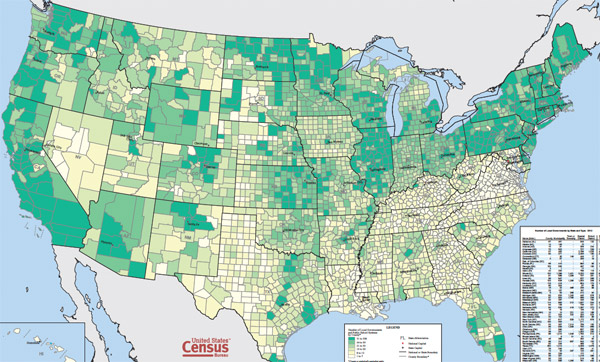People in Illinois like to complain about big government. But maybe there's a bigger problem: little government. Lots and lots of them, from municipalities to townships to special districts to school districts. Every five years the Census does a census of governments, and Illinois ranks first, as it always does, with 6,968, over 2,000 more than the runner-up, Pennsylvania. And we don't just have more governments than anywhere else; we have more of just about every kind of government the Census surveys. 2007 was the last year that a detailed breakdown was available; here are how the top four states broke down:
* Illinois, population about 12 million: 102 county governments; 1,299 municipal governments; 1,432 township governments; 912 public school systems; 3,249 special district governments (everything from the CTA to mosquito abatement districts)
* Pennsylvania, population about 12 million: 66 county governments; 1,016 municipal governments; 1,546 township governments; 515 public school systems; 1,728 special district governments
* Texas, population about 25 million: 254 county governments; 1,209 municipal governments; 1,081 school district governments; 2,291 special district governments
* California, population about 37 million: 57 county governments; 478 municipal governments; 1,102 public school systems; 58 dependent school systems; 2,765 special district governments
We have a lot of little counties, and those counties have a lot of little governments.

Dark green is the highest tier, 51-538 governments and public school systems by county. Plenty of other states have most of their counties in that tier, but we're distinguished by the number of counties among states with lots of governments per county.
Is it a matter of creeping little-big government? Not really. In 1942, Illinois had 15,854 governments. That fell to 7,723 by 1952, hit a low of 6,468 in 1982, and crept up again in the 1990s and 2000s. Why so many? It is, ironically enough, a fear of excessive government:
The 1870 Constitution limited local governments’ debt capacity, but as society progressed and residents required such services as utilities and water treatment, “those debt limits just didn’t keep up with the changing condition,” Netsch says. Municipalities couldn’t borrow enough to pay for new capital expenses without limiting their borrowing power for other established needs, so they asked the Illinois legislature to create special districts with their own taxing power.
[snip]
Netsch says that some units of local government continue to exist because those outside urban boundaries feel that their taxes would otherwise go to programs they don’t need or use, such as services for the poor.
It's an odd system. But good luck streamlining it:
The state’s libraries are typically divided into districts. One law requires coverage by a fire protection district for every property not served by a municipal fire department. In some suburbs, elementary schools feeding into a single high school are even divided into multiple districts.
“If you were starting from ground zero, you wouldn't design a system of local government like Illinois,” Redfield said.
What's more, political patronage plays a role in preserving many of the state's existing structures. "There's a relationship that develops between (politics) and all these boards," Redfield said.
Illinois is famous for its big city with its big patronage and its Chicago-style brand of big government, but by the numbers the most remarkable thing about the state is all the little ones.


